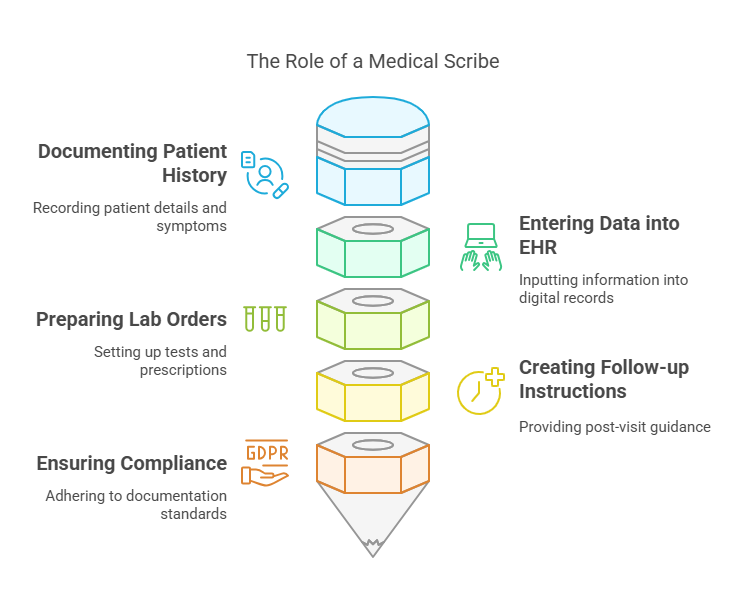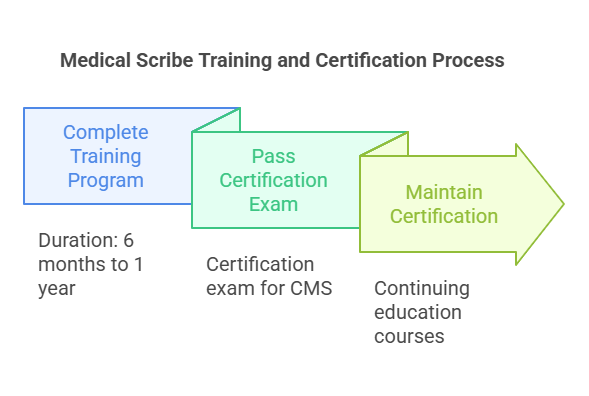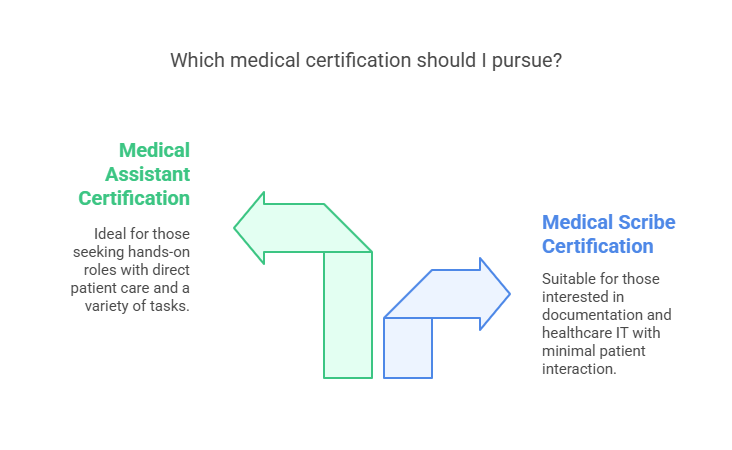Medical Scribe Certification vs. Medical Assistant Certification
In the healthcare industry, the roles of Medical Scribes and Medical Assistants are critical to ensuring smooth operations, accurate patient documentation, and effective patient care. However, while both positions play essential roles in medical settings, they differ significantly in terms of responsibilities, training, and certification processes. If you're looking to pursue a career in healthcare, understanding the differences between Medical Scribe Certification and Medical Assistant Certification can help you make a more informed decision about which path is right for you.
This blog will explore the key differences between these two certifications, the training involved, career prospects, and the roles these professionals play within healthcare teams.
What is a Medical Scribe?
A Medical Scribe is a healthcare professional who assists physicians by documenting patient interactions during medical appointments. They work closely with doctors, nurses, and other medical staff to ensure that all medical records are accurate and up-to-date. Medical scribes help improve physician efficiency by allowing the doctor to focus entirely on the patient rather than worrying about the documentation.
Key Responsibilities of a Medical Scribe:
Accurately documenting patient history, symptoms, diagnoses, and treatments.
Entering data into Electronic Health Records (EHR).
Helping with preparing orders for lab tests or medications.
Assisting with creating follow-up instructions for patients.
Ensuring compliance with medical documentation standards and regulations.
What is a Medical Assistant?
A Medical Assistant plays a broader role within healthcare settings, combining both administrative and clinical tasks. Medical Assistants are responsible for assisting healthcare providers in both patient care and office administration. They work in various medical environments, including clinics, hospitals, and private practices.
Key Responsibilities of a Medical Assistant:
Taking patient histories and vital signs (such as blood pressure and temperature).
Administering medications or injections under physician supervision.
Performing basic laboratory tests and preparing samples for analysis.
Handling administrative tasks such as scheduling appointments, billing, and coding.
Assisting in minor medical procedures or examinations.
Differences in Roles
While both Medical Scribes and Medical Assistants have roles in supporting healthcare professionals, the differences in their responsibilities are significant.
Focus Area:
Medical Scribe: Primarily focuses on medical documentation and transcription of doctor-patient interactions.
Medical Assistant: Provides both clinical and administrative support, handling tasks ranging from patient care to office management.
Clinical Involvement:
Medical Scribe: Minimal direct patient care involvement.
Medical Assistant: Significant involvement in clinical duties, including administering medications, assisting with exams, and handling patient care.
Work Environment:
Medical Scribe: Typically works alongside physicians in hospital emergency rooms, outpatient clinics, and doctors' offices, focusing solely on documentation.
Medical Assistant: Works in various healthcare settings, including private practices, outpatient clinics, and medical offices, where they balance clinical and administrative duties.
Training and Certification for Medical Scribes
Becoming a Certified Medical Scribe generally requires specialized training in medical terminology, documentation practices, and the use of EHR systems. Certification can be obtained through accredited programs, and many employers prefer hiring certified professionals.
Training for Medical Scribes:
Duration: Training programs typically last between 6 months to 1 year.
Skills Learned: Medical terminology, EHR software, HIPAA compliance, and medical transcription.
Certification Bodies: The American Healthcare Documentation Professionals Group (AHDPG) offers certification for medical scribes.
Certification Process:
Step 1: Complete an accredited training program.
Step 2: Pass a certification exam to become a Certified Medical Scribe (CMS).
Step 3: Maintain certification through continuing education courses.
Training and Certification for Medical Assistants
Medical Assistants are required to undergo formal training programs, usually lasting between 9 months to 2 years, depending on whether they pursue a certificate, diploma, or associate degree. Certification for Medical Assistants is not mandatory in all states but is strongly recommended for better career prospects.
Training for Medical Assistants:
Duration: Typically takes 9 months to 2 years.
Skills Learned: Clinical tasks like taking vital signs, administering medications, lab tests, and administrative skills like scheduling appointments and billing.
Certification Bodies: The American Association of Medical Assistants (AAMA), the American Medical Technologists (AMT), and the National Healthcareer Association (NHA) offer certification exams.
Certification Process:
Step 1: Complete an accredited training program.
Step 2: Pass the certification exam (CMA, RMA, or CCMA) to become a Certified Medical Assistant.
Step 3: Maintain certification through continuing education.
Career Prospects
Both Medical Scribes and Medical Assistants enjoy strong career prospects in the healthcare industry, but their job opportunities and salary expectations may vary.
Job Outlook:
According to the U.S. Bureau of Labor Statistics, employment of Medical Assistants is expected to grow by 16% from 2020 to 2030, much faster than the average for all occupations.
The demand for Medical Scribes is also expected to rise, particularly with the growing need for accurate documentation as healthcare facilities increasingly adopt electronic health records.
Salary Expectations:
The median annual wage for Medical Assistants is around $35,850, according to the Bureau of Labor Statistics (2023).
Medical Scribes earn a lower median salary, generally ranging between $30,000 to $40,000 annually, depending on the region and level of experience.
Similarities Between Medical Scribe and Medical Assistant
Despite their differences, Medical Scribes and Medical Assistants share several key similarities, such as:
Both roles are essential for the smooth functioning of medical practices.
Both positions require a strong understanding of medical terminology and patient care.
Both require good communication skills and the ability to work under pressure.
When to Choose Medical Scribe Certification vs. Medical Assistant Certification
The decision between pursuing Medical Scribe Certification or Medical Assistant Certification depends largely on your career goals and the type of work you are most interested in.
Choose Medical Scribe Certification if:
You are interested in documentation and assisting physicians with medical records.
You prefer a more administrative role with minimal patient interaction.
You want a faster certification process with a focus on documentation and healthcare IT.
Choose Medical Assistant Certification if:
You want a more hands-on role that includes both clinical and administrative tasks.
You enjoy direct patient care, assisting with examinations, and performing basic medical procedures.
You seek a broader range of job opportunities in medical offices, clinics, or hospitals.
Less Commonly Known Facts About Medical Scribe and Medical Assistant Certifications
Medical Scribes often use speech recognition software to transcribe patient encounters, improving speed and accuracy.
Speech Recognition Software in Healthcare
Medical Assistant programs often include externships, giving students real-world experience before certification.
Externships for Medical Assistants
Medical Scribes help reduce physician burnout by taking over documentation tasks, which can reduce cognitive load on doctors.
How Medical Scribes Help Prevent Burnout
Medical Assistant Certification is a requirement in some states for those who want to perform clinical tasks like injections.
State Certification Requirements for Medical Assistants
Medical Scribes may need to stay updated on EHR changes, as software systems evolve and update regularly.
EHR Software Updates and Their Impact on Medical Scribes
Medical Assistants can specialize in areas like podiatry, optometry, or gynecology, offering diverse career paths.
Specializations for Medical Assistants
Medical Scribe Certification often leads to roles in medical coding and billing due to the deep familiarity with medical documentation.
Medical Coding and Billing Careers for Medical Scribes
Medical Assistant certifications can also include specialized training in areas like phlebotomy or electrocardiogram (EKG) administration.
Medical Assistant Specializations: Phlebotomy and EKG
Medical Scribes often have flexible work schedules, with opportunities for remote work in some cases.
Remote Opportunities for Medical Scribes
Medical Assistants are sometimes responsible for inventory management, ensuring the clinic or practice has necessary medical supplies.
Medical Assistants and Inventory Management
Conclusion
Choosing between Medical Scribe Certification and Medical Assistant Certification depends on your interests and long-term career goals. Medical Scribes are integral in supporting physicians with documentation, while Medical Assistants balance clinical and administrative duties. Both certifications open doors to fulfilling careers in the healthcare industry, with ample growth potential and job security. At ACMSO, we offer comprehensive training programs for Medical Scribe Certification and other healthcare certifications. As a leader in medical training, we understand the importance of hands-on learning, and we are committed to providing high-quality education that aligns with industry standards. Our Medical Scribe Certification ensures that you are well-prepared for the dynamic healthcare environment, empowering you to pursue your professional goals with confidence.
FAQs
-
A Medical Scribe focuses on medical documentation and assisting with patient records, while a Medical Assistant handles both clinical tasks and administrative duties in healthcare settings.
-
Yes, it’s possible to transition from a Medical Scribe to a Medical Assistant by completing the necessary training and certification.
-
Both certifications offer great opportunities, but the choice depends on whether you prefer administrative tasks or a more hands-on role in patient care.
-
While not required by law, certification is often preferred by employers and can improve job prospects and salary potential.
-
Medical Scribe training typically takes between 6 months to 1 year, depending on the program.






